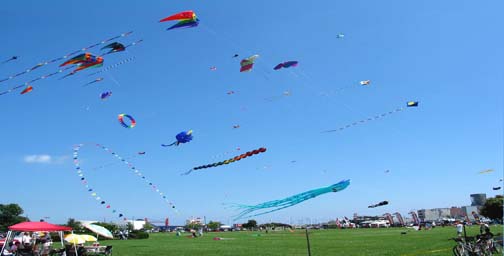The Wonder and Science of Kite Flight:
The variety of kite shapes, sizes and types often fills us with wonder as we look into the sky. How is it that something that is heavier than air can fly? How can it stay suspended in the sky with no means of propulsion?
Why do kites of differing shapes fly? How does size and weight affect the ability of a kite to fly? Do different types of kites have different flying capabilities?
All of these questions, and more, fill our heads as we look up at the array of kites that fill a sky at a local club kite meet or a large festival.

It is indeed a wonder that so many varieties and sizes of kites can fly. Different kite types have differing flight characteristics and kite builders are always trying to find an ideal shape and structure to fly in different wind conditions.
In addition to wondering about how kites fly, there is a special, mystical kind of "wonder" that sweeps over the kite flyer as the kite leaps to life and leaves one's hand for the distant reaches of the sky. Bound only to the flyer by the control line(s), the kite enters into a zone where different forces affect the kite. If these forces are properly balanced out and the kite is tuned to them, the flight is stable, controlled, and constant. If the forces are not properly blanced, flight problems will occur and make the kite difficult or impossible to keep in the sky.
_______________
How Kites Fly:
Kites are heavier than air devices that are capable of flight at the end of a tether (line). Since a kite has no built in propulsion system it requires the motion of air over and around it to cause it to rise and stay aloft.
Gravity pulls all objects toward the center of the earth. Therefore other forces on the kite must offset the basic pull of gravity which is trying to prevent the kite from flying.
The main energy source working on the kite is the "wind". Air is made up of moving particles (atoms) which move from one direction to another. When the direction of movement of these particles is in a constant direction and of sufficient speed, the energy force known as wind is created.
In order for the kite to use the energy source (wind) to offset the pull of gravity, the kite must be positioned or angled in such a way to cause the wind to be split over the surface of the kite into two distinct streams of air.
If the angle of the kite creates a difference in the airflow over the top of the kite and the bottom of the kite a force known as "lift" is created. The angle that the surface of the kite presents to the wind causes a change in flow of air. The airflow splits over the top and bottom of the kite turning it into an "airfoil". Airplane wings, bird wings, sails on a boat and kites are all airfoils.
The concept of "lift" is in accordance with Bernouilli's Principle that when the wind blows on an airfoil (curved or angles wing surface), the air flow immediately above the topside of the kite will be faster and the air pressure on that side will be reduced. In a similar fashion, the air flow diverted downward moves more slowly causing air pressure on that side to increase. This situation creates a type of "vacuum", or reduced pressure on top of the kite in comparison to the bottom of the kite, resulting in "lift" which carries the kite aloft. The changes in pressure from one side of the kite to the other are very small, but they are enough to create upward movement on the kite.
The amount of lift required to cause a kite to rise depends on the overall weight of the kite in comparison to the surface area of its sail(s).
One additional force works on a kite to work against lift. The kite presents an amount of frictional resistance to the wind. This force is known as "drag". Drag reduces the lift of a kite and will cause it to fly lower on the horizon. Kite flyers try to build kites and fly them at angles that will reduce the friction of the air on the kite and maximize the amount of lift to carry and keep the kite aloft.
__________
Balance and Stability
In outlining the main forces that come into play in causing a kite to fly:
- wind = energy
- angle of kite = airfoil splitting the wind over the surface of the kite
- lower air pressures on top than on bottom of kite = lift
- friction resistance on the kite = drag
it is assumed that the design of the kite has ensured good balance and stability.
In other words, the kite needs to be of equal weight on each side of it's centre of balance and it needs to be carefully constructed to ensure that one side is not heavier than the other.
Additional Resources:
Davison, Glenn. Kites in the Classroom. AKA American Kitefliers Association, 2002. (Downloadable in PDF format from the AKA web site.)
Eden, Maxwell. The Magnificent Book of Kites. Sterling Publishing Co. Inc. New York. 1998. ISBN: 0-8069-4990-2
Ito, Toshio and Komura, Hirotsugu. KITES The Science and the Wonder. Japan Publications, Inc. Tokyo, 1983.Morrison, Skye; Graves, Michael; Atkins, Ilene. Kite Crazy. (The book which accompanied the SOMA video series for TV-Ontario.) TVO, Toronto Canada. 1993.




